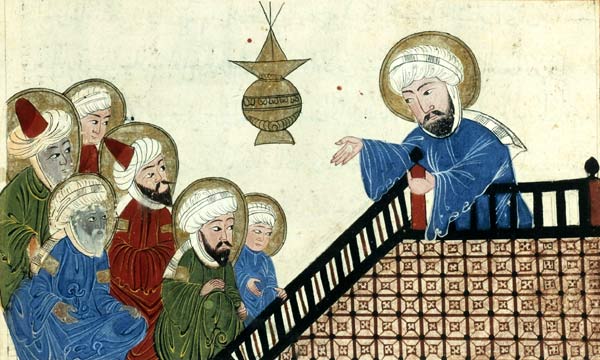 |
This is a file from the Wikimedia Commons. Information from its description page there is shown below.
Commons is a freely licensed media file repository. You can help.
|
Summary
| Description |
English: The Islamic Prophet Muhammad, 17th century Ottoman copy of an early 14th century (Ilkhanate period) manuscript of Northwestern Iran or northern Iraq (the "Edinburgh codex"). Illustration of Abū Rayhān al-Bīrūnī's al-Âthâr al-bâqiyah ( الآثار الباقيةة ; "The Remaining Signs of Past Centuries")
Français : Le prophète de l'islam Mahomet, illustration d'un manuscript ottoman du 17e siècle
|
| Date |
17th century |
| Source |
BNF, MS Arabe 1489, fol. 5v. (literature: Thomas Walker Arnold and Adolf Grohmann. The Islamic Book: A Contribution to Its Art and History from the VII–XVIII Century. Paris: Pegasus Press; New York: Harcourt, Brace and Company, 1929. ) immediate source:
|
| Author |
Unknown |
Licensing
This is a faithful photographic reproduction of an original two-dimensional work of art. The work of art itself is in the public domain for the following reason:
| Public domainPublic domainfalsefalse |
 |
This work is in the public domain in the United States, and those countries with a copyright term of life of the author plus 100 years or less. |
|
This file has been identified as being free of known restrictions under copyright law, including all related and neighboring rights.
|
The official position taken by the Wikimedia Foundation is that "faithful reproductions of two-dimensional public domain works of art are public domain, and that claims to the contrary represent an assault on the very concept of a public domain". For details, see Commons:When to use the PD-Art tag.
This photographic reproduction is therefore also considered to be in the public domain. Please be aware that depending on local laws, re-use of this content may be prohibited or restricted in your jurisdiction. See Commons:Reuse of PD-Art photographs.
|
File usage
The following pages on Schools Wikipedia link to this image (list may be incomplete):
SOS Childrens Villages has brought Wikipedia to the classroom. SOS Children's Villages helps more than 2 million people across 133 countries around the world. Want to learn more? Go to http://www.soschildrensvillages.org.uk/sponsor-a-child



